Content warning for visual depiction of violence and gore.
I have a confession to make. I still haven’t watched an episode of Vikings despite everyone and their dogs advising me to do so. And for a history nerd such as myself, who consumes every period drama she can put her filthy hands on, I have been led to understand that this is a shame. However, that doesn’t mean that I didn’t encounter Vikings in my media consumption, just not in TV shows. My Viking encounter was through Makoto Yukimura’s historical manga: Vinland Saga.
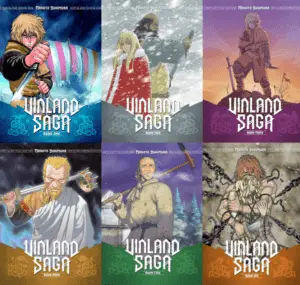
A bit of context here is needed. Mangas and Japanese culture are big in France. Like BIG. We represent 50% of all the European manga’s market and some consider France to be the largest importer of Japanese mangas in the world. Comics culture might still be struggling in baguette land but we are all weeaboos by now. For the uninitiated, a ‘weeaboo’ is someone of non-Japanese descent who really likes Japanese culture, typically manga and anime (but I have heard that a similar enthusiasm from Japanese toward French culture exists under the denomination ouiboo, so it makes things okay, I guess?). So, having fell in that magic potion quite young (yes that’s a reference to Asterix), it’s only natural that my encounter with Vikings was through manga rather than TV. French TV has a tendency not to be up-to-date with international shows anyway, and that’s an understatement.
So what is it about? Vinland Saga follows the steps of Thorfinn Karlsefni, a real Icelandic explorer, from his desire for vengeance to his attempt to establish a settlement in Vinland (what the Vikings called North America). His route leads him to meet other historical characters such as Leif Eriksson and Canute, Cnut the Great, but also a lot of interesting original characters. While being mainly a work of fiction, since little of Thorfinn’s life is known outside of his Vinland expedition (which still hasn’t started in the manga as it is ongoing), it still delves into historical events like the Viking conquest of England. And it’s good. Oh boy it’s good!
And it’s not only good because the art is gorgeous and detailed (and testifies to the huge progression of the author/illustrator). Or because the action is well rendered. No it’s because Vinland Saga, up until now, is the poster child for how you do storytelling well in every step of your work.
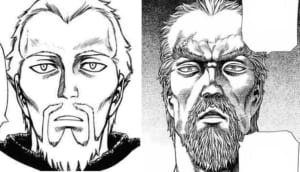
A Strange Theme for a Viking’s Story
As bizarre as it can appear for a work about Vikings, who were great merchants but also a culture where death on the battlefield was glorified and honor was a big deal, Vinland Saga is a pacifist anti-revenge narrative. It’s unsurprising for a Japanese work, just look at Hayao Miyazaki’s work like Princess Mononoke, Kaze Tachinu, and Howl’s moving Castle. Still, it’s quite ingenious.
Glorification of the warrior figure and of bloody revenge for one’s offended honor used to be a big thing in Japanese culture. Using Viking culture, the author can speak to subjects valued by his own culture and that his culture can understand while still being exotic. The setting, the conquest of the creation of a kingdom, also allows him to create a less artificial context for the philosophical battle between achieving peace through peaceful methods versus fighting a war to end all wars. This is particularly striking in the confrontation between Thorfinn and Canute.
And it’s not just a philosophical debate. Makoto Yukimura is very clear about the disastrous consequences of war. Not only among warriors and kings, but also for those left behind living terrible losses, including the civil population and the slave trade. Indeed Vinland Saga addresses the issue of slavery particularly well by making it unacceptable, period. Even the good master narrative is thrown under the bus. Owning human beings is wrong no matter what, and you can’t remain a entirely good person if you do so.
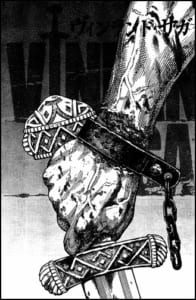
Hurray! With the combined choice of theme and setting, we are already off to a good start.
The Art
Manga is a visual media so the art, besides being beautiful, must serve the storytelling. If the covers and Askeladd’s (second) face haven’t proven to you that Makoto Yukimura’s art is beautiful here is another example:
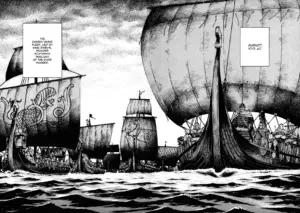
So yeah, the art is up to the task, but does it serve the narrative? With the first part of the manga (volumes 1 to 8) so centered around war and the overall work relying on actions scenes, it could easily become a glorification of violence and gore, which would work against what the story tries to tell us. I will admit that it’s violent and there is gore, but it’s done with enough cleverness to work with the theme. This, for example:
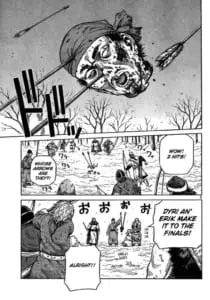
If you can’t tell, archers are having a contest using someone’s head as a target and enjoying themselves. The only thing is, it’s not just anyone’s head, it belongs to a character known as the Ear. He may not be anyone’s fave or even have a lot of personality, but he’s a known character. Using the severed head of a character that you know rather than anyone else’s head makes the horror more real. War kills people. Not nameless figures, but people. Some take pleasure in this, but we’re not supposed to. So, nope, no glorification of violence to be found here.
Sometimes, Makoto Yukimura even decides not to show us particular acts of violence. He implies it, though, which doesn’t make it any less horrid. The following image, for example, is the more graphic drawing we are given of the massacres of an entire village.
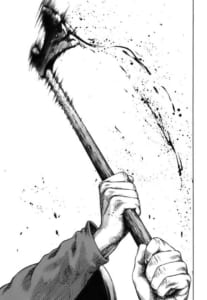
Since the author has made us spend a bit of time with those villagers, has shown us that some characters are against it, and has made a survivor watch it from her hiding place, the entire thing is disturbing to read. What happened to those villagers is awful, monstrous, wrong and cold. In this situation, Yukimura believes there is no need to show us more blood to make us understand.
As a general rule, I would say Makoto Yukimura’s art is never edgy just to be edgy. Take, for example, his depiction of women. They are never sexualized and are drawn as actual functioning human beings. Shocking I know.
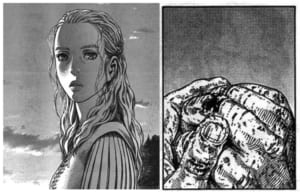
That’s Arneis, a woman presented as one of the most beautiful of the story, and those are her hands. She does manual labor, so it’s unsurprising that they’re calloused and dirty. At the same time, artists rarely give us realistic depictions of women’s body parts that are less than perfectly beautiful. So yeah the art is incredible, vibrant, and helps tell the story and set an appropriate tone. Have I convinced you yet?
Characterization, or Everyone Has a Lot of Issues and Everyone is Hurt
A story is nothing without its characters. There are plenty of them in Vinland Saga, all with different ways of thinking and different objectives. It has something for every taste.
- Thorfinn is the angry warrior looking for vengeance that the loss of his objective will break before leading him to new heights.
- Askeladd is the cunning leader who kills everyone’s father figures (literally, even his) and has a master plan. He is an asshole, and he is my fave.
- Bjron is the typical Viking warrior.
- Thors is the repentant warrior.
- Canute is the reluctant and unconventional prince who will be called to higher purposes.
- Leif Eriksson is the honorable and very talented sailor.
- Thorkell is our typically over-enthusiastic warrior.
- Einar is the newly made slave angry at life (and who wouldn’t be).
- Arneis is the resigned slave who is still kind and compassionate but, at the same time, strong and patient.
- Helga is the beautiful, willful Viking girl far too strong for her size.
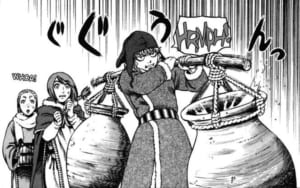
- Hild is the vengeful huntress.
- Gudrid is the girl who dreams of something other than the life that was assigned to her and acts on her dreams.
It’s a lot, I know, and I even left many out! There are a lot of secondary characters, and every tertiary character is given a personality and dialogue. l can’t begin to talk about them all without transforming this piece into a list. What you need to know is that every character has a personality and is allowed to express it. You’ll probably get a bit attached to nearly everyone. I did. (I lied, I don’t care about Ketil and his first son, they can burn in hell as far as I am concerned).
Even more, characters are allowed to grow, to form new friendships and deal with their traumas and their losses, everyone in their on way. Some of them are broken by the story and become weaker and meaner versions of themselves. Others learn to fight against fate, question themselves, and become stronger persons. Just like trauma, loss, and war does to real people.
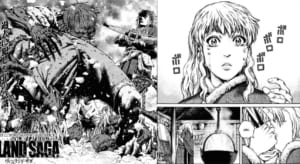
Once again allowing every character to have personalities, goals and emotions and allowing them to change serves the theme. We know these people and what they have been through. We love them or despise them for it, but their fates touch us. As the story progresses, we want them at peace, every single one of them, and that’s a powerful way to carry a pacifist message.
Conclusion
Vinland Saga is powerful story told with amazing art and great characters. It’s true that some moments play dangerously with your suspension of disbelief (are they carrying a war boat here???? Yes they are!?) but that’s consistent with the manga’s genre. If you are into history-based stories, into mangas (or want to give them a try) it’s a must read.
Even more so because Makoto Yukimura took a risk with his storytelling. The first arc was a real emotional roller coaster with lot of epic confrontations. To continue to make sense with what he wanted to say, he intentionally slowed down the story in the second arc. It may seem odd, but it was necessary in order to allow the story to reaccelerate afterward without losing sight of the characters’s motivations. Even if the second arc is slow, it pays off well. Nevertheless, the choice alienated some of his readers who were there for blood and glory, i.e., those who didn’t realize that the story was against these things from the beginning.
And it still could go wrong. It’s far from over, and sensitive matters are still to be addressed, such as how the Native Americans are depicted. However, the courage of the author makes me think there’s a good chance for the rest of the manga to be as good as what’s already completed. Up to this point, Vinland Saga is a very good story and a masterpiece of visual storytelling. Give it a try. And never let D&D get close to it!

